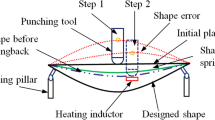Abstract
In this study, design and fabrication of a flexible forming machine are carried out for the purpose of manufacturing a prototype of curved plate block for hull structure used in shipbuilding industry. Flexible forming dies which consist of numbers of punches in an array form for upper and lower sides are designed in view of thick plate forming. A punch has formation of male and female screws to adjust its length with regard to a given surface, and all punches are supported by each other in punch housing. Software for process configuration and punch control are developed to operate the novel flexible forming machine. The software are composed of the punch height calculation part which uses an offset surface scheme. Prior to manufacturing of a prototype, numerical simulations for a saddle-typed thick plate forming process including metal forming and spring-back analyses are carried out to predict the forming performance. Experiments are also carried out to validate and confirm the feasibility of flexible forming technology in view of practical application of thick plate forming process. Curvature radii observed in the simulation and experiment are investigated and compared. Consequently, development and practical application of flexible forming technology to the thick plate forming process are described from design of the forming machine to manufacturing of the prototype. It is confirmed that the flexible forming technology suggested in this study has enough feasibility in new application of thick plate forming in shipbuilding structures which has been formed through expensive and laborious conventional line heating.
Similar content being viewed by others
References
Jang CD, Moon SC, Ko DE (2000) Acquisition of line heating information for automatic plate forming. Proceeding of Ship Structures Committee Symposium, Doubletree Hotel Crystal City, VA, pp 1–6
Olsen BA (1981) Die forming of sheet metal using discrete surfaces. Dissertation, Massachusetts Institute of Technology
Li MZ, Cai ZY, Liu CG (2007) Flexible manufacturing of sheet metal parts based on digitized-die. Robot Comput-Integr Manuf 23:107–115
Li MZ, Liu YH, Su SZ, Li GQ (1999) Multi-point forming: a flexible manufacturing method for a 3-d surface sheet. J Mater Process Technol 87(1–3):277–280
Cai ZY, Li MZ (2001) Optimum path forming technique for sheet metal and its realization in multi-point forming. J Mater Process Technol 110:136–141
Cai ZY, Li MZ (2002) Multi-point forming of three-dimensional sheet metal and the control of the forming process. Int J Press Vessels Piping 79(4):289–296
Li MZ, Cai ZY, Sui Z, Yan QG (2002) Multi-point forming technology for sheet metal. J Mater Process Technol 129(1–3):333–338
Cai ZY, Li MZ (2005) Finite element simulation of multi-point sheet forming process based on implicit scheme. J Mater Process Technol 161(3):449–455
Peng LF, Lai XM, Li MZ (2006) Transition surface design for blank holder in multi-point forming. Int J Mach Tools Manuf 46(12–13):1336–1342
Zhang Q, Dean TA, Wang ZR (2006) Numerical simulation of deformation in multi-point sandwich forming. Int J Mach Tools Manuf 46(7–8):699–707
Zhang Q, Wang ZR, Dean TA (2007) Multi-point sandwich forming of a spherical sector with tool-shape compensation. J Mater Process Technol 194(1–3):74–80
Zhang Q, Wang ZR, Dean TA (2008) The mechanics of multi-point sandwich forming. Int J Mach Tools Manuf 48(12–13):1495–1503
Yoon SJ, Yang DY (2003) Development of a highly flexible incremental roll forming process for the manufacture of a doubly curved sheet metal. CIRP Annals - Manuf Technol 52(1):201–204
Yoon SJ, Yang DY (2005) An incremental roll forming process for manufacturing doubly curved sheets from general quadrilateral sheet blanks with enhanced process features. CIRP Annals - Manuf Technol 54(1):221–224
Park JW, Hong YS, Lim SH (2000) Dieless forming apparatus. US Patent 6151938
Author information
Authors and Affiliations
Corresponding author
Rights and permissions
About this article
Cite this article
Heo, SC., Seo, YH., Ku, TW. et al. A study on thick plate forming using flexible forming process and its application to a simply curved plate. Int J Adv Manuf Technol 51, 103–115 (2010). https://doi.org/10.1007/s00170-010-2615-5
Received:
Accepted:
Published:
Issue Date:
DOI: https://doi.org/10.1007/s00170-010-2615-5




